

WEEK 22: MAY 24-30
TOPIC: LARGE GROUND METEORITES
The general topic of meteorites was discussed as a “Special Topics” presentation four weeks ago. The large majority of meteorites that are known are not especially large, being of the order of a few kg in mass; with only a handful of exceptions, even the larger ones tend to have a mass of no more than a few tens of kg. Meteorites that are much larger than this tend to be quite rare, and not too many of these are known.
The discussion of what constitutes the “largest” meteorites is somewhat a matter of definition. Many incoming meteors tend to fragment as the pass through the atmosphere, and whatever fragments – or complete meteorites, for that matter – that hit the ground might subsequently be broken apart, sometimes by humans or perhaps by weathering or other causes. The “largest” meteorites can therefore mean the largest individual fragments, or it can mean the largest combined mass of all the various fragments. For the purposes here, I will generally use “largest” to mean the largest individual fragments, although at times I might consider it appropriate to include the combined fragments as part of the overall discussion.
With only a few exceptions, almost all of the largest known meteorites are of the iron-nickel type. Even though these are relatively rare compared to stony meteorites, they are significantly denser, i.e., more massive per volume, than similarly-sized stony meteorites, and are also much more likely to survive their passage through the atmosphere without disintegrating. The largest known stony-iron meteorites are two fragments of the Brenham meteorite found near Haviland, Kansas (and which are possibly associated with an impact crater near there); these have masses of 650 kg and 450 kg. The largest stony meteorite known is apparently a 654-kg fragment of the Chelyabinsk meteorite that fell near Chelyabinsk, Russia on February 15, 2013 (and which is discussed as part of a future “Special Topics” presentation).
Almost all of the largest iron meteorites are the results of falls that took place thousands of years ago. (The largest iron meteorite resulting from an observed fall is apparently a 1745-kg fragment of the Sikhote-Alin meteorite that fell in Siberia on February 12, 1947; this is discussed, along with the Chelyabinsk meteor and other recent Earth “impacts,” in a future “Special Topics” presentation.) Many of these meteorites have been known, and sometimes venerated, by indigenous peoples for many centuries, and have been “discovered” and identified as meteorites, and scientifically analyzed as such, only within the relatively recent past.
Analysis indicates that the Hoba meteorite fell to Earth approximately 80,000 years ago. There are no impact craters or other known features associated with it, possibly due to a relatively slow impact velocity and/or skipping along the ground after
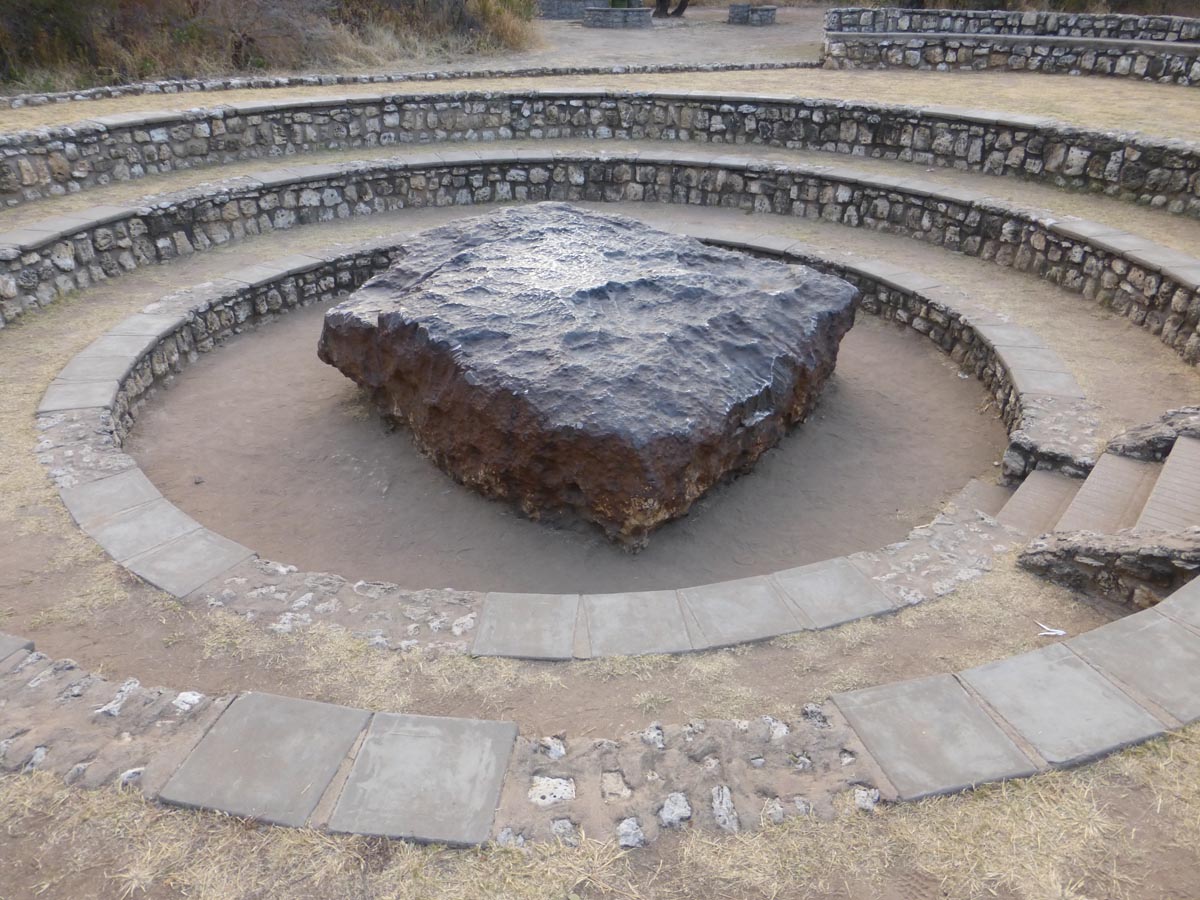
Another large meteorite in Africa is Mbozi, near the city of Mbeya, Tanzania. Indigenous peoples called it “kimondo,” and it was later “discovered” by scientists in 1930. It has a mass of 16 tons and, like Hoba, there is no nearby impact crater; it, too, may have rolled along the surface after impact.
One of the other large single meteorites is the Bacubirito meteorite, discovered in 1863 by geologist Gilbert Bailey near the village of Ranchito in the Mexican State of Sinaloa. It is roughly 4 meters long by 2 meters wide, with an approximate mass of 22 tons, and is presently located at the Centro de Ciencias de Sinaloa.
Certainly one of the largest multiple-fragment meteorites is the Campo del Cielo (“Field of Heaven”) set of meteorites located near the border of the provinces of Chaco and Santiago del Estero in northern Argentina. Indigenous peoples in the area had known of these rocks for centuries, even constructing weapons out of them, and it was examined by an expedition commissioned by the provincial Governor in 1576. The meteorites cover a strewnfield 18 km long by 3 km wide that contains numerous impact craters, attesting to the original meteorite fall that took place approximately 4500 years ago and that is described in the indigenous peoples’ legends.
Many fragments of the Campo del Cielo field have been recovered, most within the fairly recent past. The El Chaco fragment, located in 1969 and extracted in 1980, has a mass of 29 tons, and meanwhile, the largest fragment, Gancedo – discovered underground by the Asociacion de Astronomia del Chaco as recently as September 10, 2016 and later unearthed – has a mass of 31 kg, making it the third-largest meteorite fragment identified on Earth to date.
Another significant collection of meteorite fragments is the set of Aletai meteorites that have been found in the Xinjiang Ulyghur Autonomous Region in northwestern China. The largest fragment, Armanty, with a mass of 28 tons, was “discovered” in 1898, and another large fragment, Akebulake, with a mass of 18 tons, was “discovered” as recently as 2011. Both fragments carry “graffiti” in the form of signatures inscribed upon them apparently by passing herdsmen.
One of the most famous large ground meteorites is the Cape York meteorite, in actuality a group of several large fragments near Cape York in far northwestern Greenland. The Inuit population who lived near there were well aware of the meteorites and utilized the iron within them to build tools and harpoons. In 1818 a British Naval officer, John Ross, was leading an expedition for the fabled “northwest passage” and encountered several members of the Inuit population, and upon examining their metal tools correctly concluded that they came from an iron meteorite, however the local people would not reveal the location of their source of iron.
Several expeditions over the next few decades tried to find this meteorite, but failed. Finally, in 1894 American Naval officer and famed Arctic explorer Robert Peary led another expedition and gained the trust of the Inuit population, and on May 27, together with fellow expedition member Hugh Lee and an Inuit guide name Tallakoteah, located the fabled “Iron Mountain” and at least three fragments on a small island called “Saviksoah” by the native population but now known as (for obvious reasons) “Meteorite Island.” Over the next three years Peary successfully brought these three fragments to the U.S.; the largest, named Ahnighito by Peary, has a mass of 31 tons and is the second-largest meteorite found thus far on Earth; it is on display at the American Museum of Natural History in New York. A Danish scientist, Vagn Buchwald, discovered a fourth large fragment of the Cape York meteorite in 1963 on Greenland’s Agpalilik peninsula (and thus is named “Agpalilik”); this fragment, with a mass of 20 kg, is on display at the Natural History Museum of the University of Copenhagen.
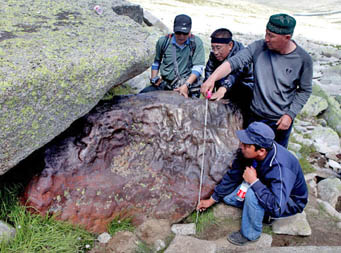
 LEFT: Chinese researchers measuring the recently-discovered Akebulake meteorite in China. Image courtesy Xinhua. RIGHT: Robert Peary with the Ahnighito fragment, the largest fragment of the Cape York meteorite, on site in Greenland. From Peary’s memoir “Northward Over the Great Ice.”
LEFT: Chinese researchers measuring the recently-discovered Akebulake meteorite in China. Image courtesy Xinhua. RIGHT: Robert Peary with the Ahnighito fragment, the largest fragment of the Cape York meteorite, on site in Greenland. From Peary’s memoir “Northward Over the Great Ice.”
Analysis of the Cape York meteorite fragments indicates that it fell to Earth at least 10,000 years ago and quite possibly much earlier than that. In 2018 a large circular basin – quite possibly an impact crater – 31 km in diameter was detected approximately 1 km below the ice surface of the Hiawatha Glacier in northwestern Greenland. While it has not yet been possible to date the age of this “Hiawatha Crater” directly, indirect evidence suggests that it is likely between 12,000 and 50,000 years old – consistent with the possible fall date of the Cape York meteorite. (There is indeed indirect evidence that this putative crater was formed by the impact of an iron-rich asteroid.) There has even been speculation that the putative Hiawatha Crater – and, thus, the Cape York meteorite fall – might be associated with the Younger Dryas climate change era that took place approximately 12,000 years ago, but this idea is not widely accepted at this time.
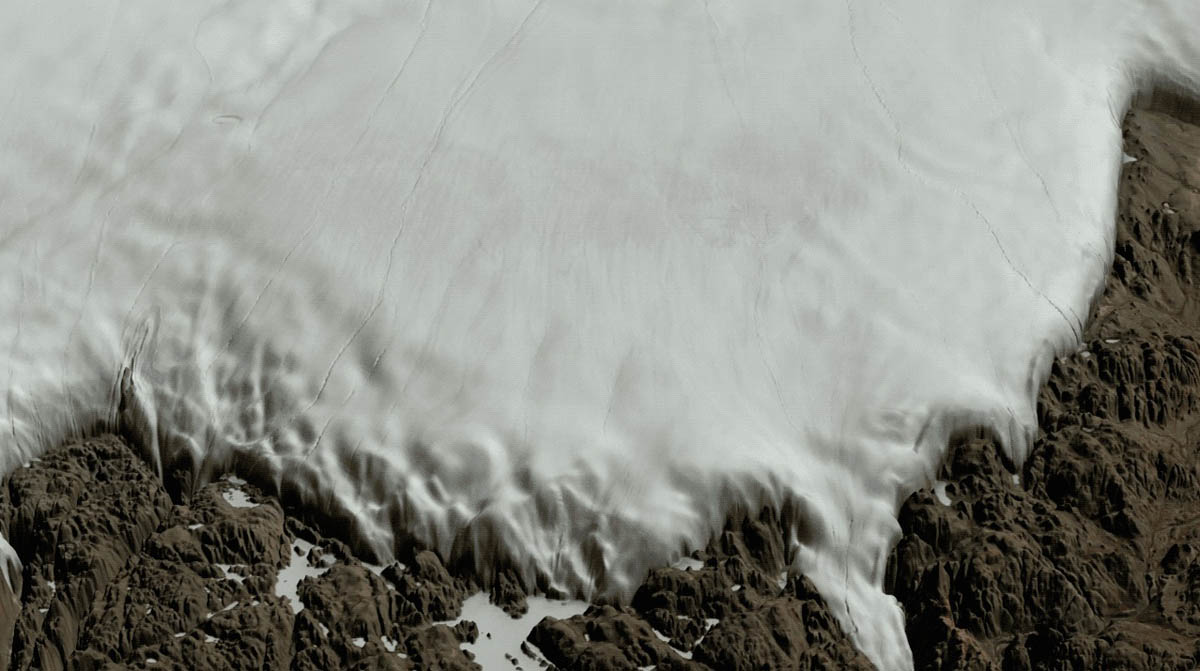
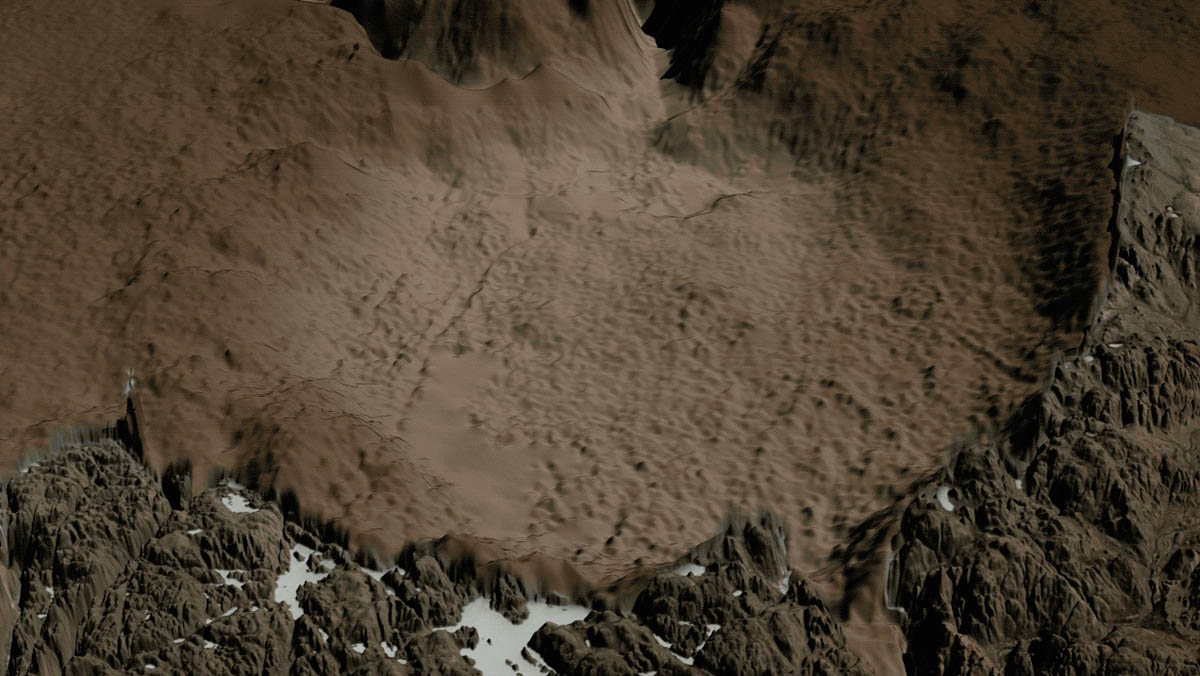 The Hiawatha crater in northwestern Greenland. Left: Photograph of the Greenland Ice Sheet. Right: Topography of the rock underneath the ice sheet, showing the outline of the crater. Images courtesy NASA.
The Hiawatha crater in northwestern Greenland. Left: Photograph of the Greenland Ice Sheet. Right: Topography of the rock underneath the ice sheet, showing the outline of the crater. Images courtesy NASA.
A rather colorful story surrounds the Willamette meteorite, which with a mass of 14 tons is the largest meteorite found in the U.S. (in the Willamette River valley in northwestern Oregon). It had been long known and considered sacred by the indigenous Native American peoples of that region, and was then “discovered” in 1902 by a Welsh immigrant settler, Ellis Hughes. Realizing the significance of what he had found but also realizing that it was not on his property, Hughes, assisted by his teenage stepson, clandestinely worked to move the meteorite to his property, taking three months to do so. Upon completing this task he built a small shed around it and charged admission, but one of those who came to view it was the attorney for the property owners where Hughes had found the meteorite, the Oregon Iron and Steel Company. The company sued Hughes to get the meteorite back, and Hughes took the case all the way to the Oregon Supreme Court, who ruled against him with the argument:
“A meteorite or aerolite, though not imbedded in the earth, is nevertheless real estate, belonging to the owner of the land, and not personal property, in the absence of proof of severance.” (Oregon Iron Co. v. Hughes, 1905)
There is no impact crater anywhere near the site where the Willamette meteorite was found, and researchers believe that it fell several thousand years ago, during the last Ice Age, in southern Canada or Montana. After landing on top of the ice cap that covered the area at that time, it was later carried
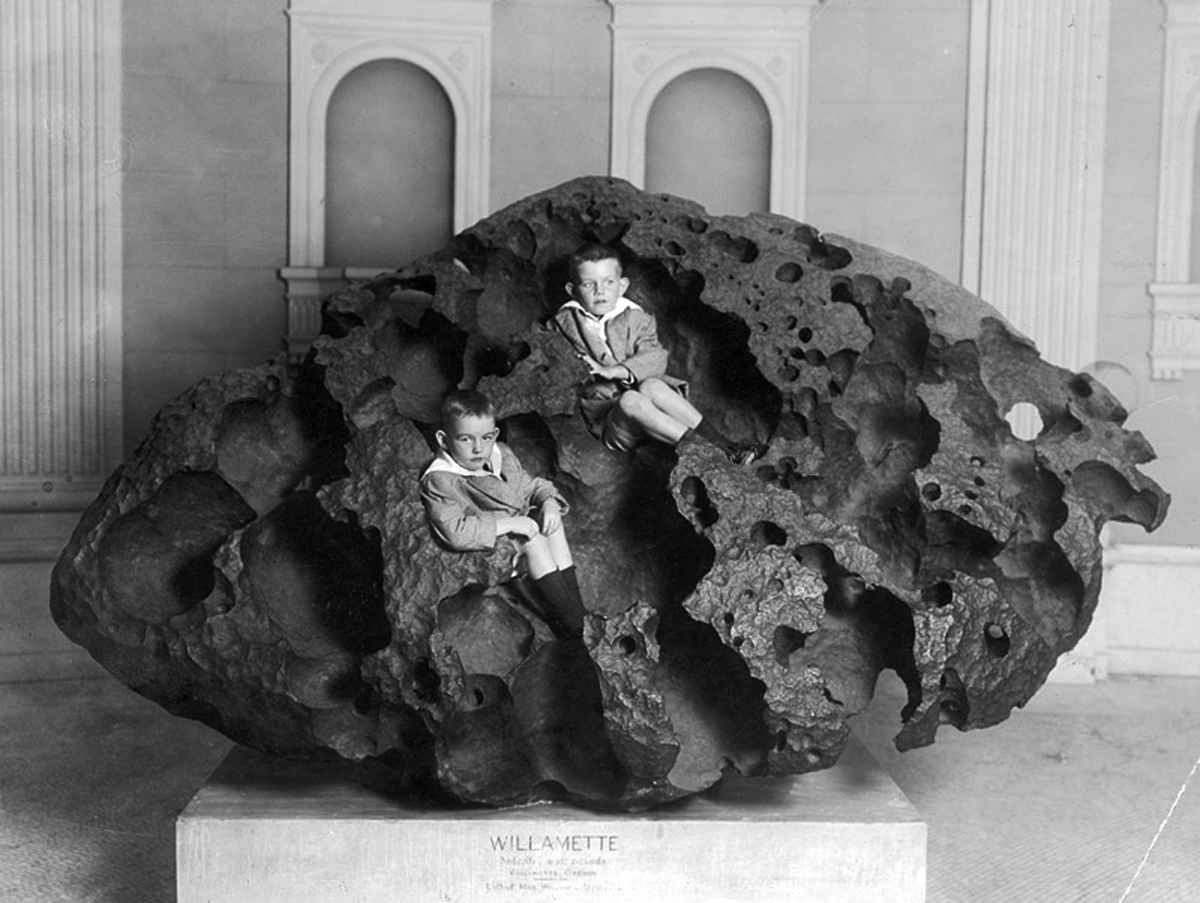
The fact that some of the largest meteorites found on Earth have only been identified within the past decade, e.g., the Gancedo and Akebulake meteorite fragments, suggests the possibility that more such objects remain to be found. There are still many locations on Earth’s surface – including, certainly, on the ocean floor, although weathering would likely play a significant factor there – that are accessible only with difficulty and that remain largely unexplored, and thus future intrepid explorers might yet be able to add to this description of large ground meteorites.
“Special Topics” archive
Ice and Stone 2020 home page
Earthrise Institute home page